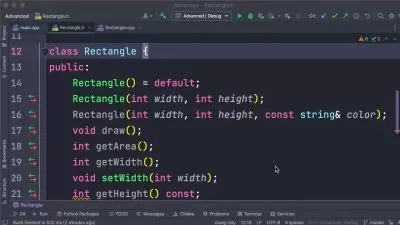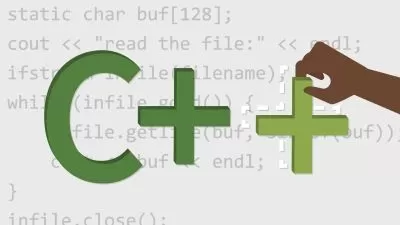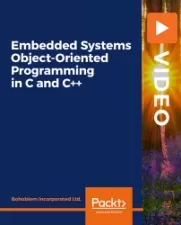C Programming For Beginners - Master the C Language
Tim Buchalka's Learn Programming Academy,Jason Fedin
25:36:22
Description
C Programming will increase career options. Become a better dev in other languages by learning C. Pointers explained
What You'll Learn?
- Understand the fundamentals of the C Programming Language
- Make yourself more marketable for entry level programming positions
- Create your first C Application
- Learn one of the most popular, widly used languages in the world
- Understand variables and the different data types
- Apply for real-time programming positions
- Understand the core language that most modern languages are based on
- Learn how to write high-quality code
Who is this for?
What You Need to Know?
More details
DescriptionHave you never programmed a computer before, and think or have been told that C is a good programming language to get started with.  It is!
Maybe you have some experience with other programming languages, but want to learn C. Â It's a great language to add to your resume!
Or perhaps you are stuck in a low paying programming job, and want to move up to a better, more senior position. Â Learning C can help you!
The fact is, learning how to program in C is not only an excellent programming language to get started with, but it will also make you a better programming in other computer languages!
Why learn C ?
C is often considered to be the mother of all languages because so many other languages have been based on it.
Though C is simple it is one of the most powerful languages ever created.  Considering it was created over 40 years ago, it is still used heavily and is usually in the top 5 or 10 most popular and most widely programming languages in the world.
Learning C can actually make you a better programming in other languages like C++, Java, or C# by equipping you with a mental model of what the computer is actually doing when you run your programs.
By learning how things really work "under the hood", and understand memory space, CPUÂ architecture and so on, you can create more efficient programs, and obtain a huge advantage over other programmers in the process.
If you want to become a better developer, learning C is a great way to start!
Why enrolling in this course is the best decision you can make.
By the end of this course, you will understand the fundamentals of the C Programming Language, and make yourself more marketable for entry level programming positions.
You will understand variables and the different data types, be able to utilize functions and arrays, understand the  concept of pointers, learn about control flow (decision statements and iteration).
You will be in a position to apply for real-time programming positions, and truly understand the core language that most modern languages are based on!
If you have previously used the C programming language, then this course will deepen your understanding of it. If you have never used it, no problem, you will see that it can help you become a more efficient C developer.
The course will be constantly refined in the future based on student feedback!
This course does not skip on the details. You will learn how to write high quality code and become an excellent problem solver. This course does not just present how to code in the C programming language, but, also includes all the details on "why" you are doing the things you are doing. At the end of this course, you will fully understand the concepts of the C Programming language.
Your instructor, Jason Fedin has been teaching students for over 12 years via online classes at over 10 different online Universities. He has created many different class curriculums, ranging from mobile programming to bash scripting to Object-Oriented Design and of course the C programming language.
Additionally, he has been developing software for over 16 years in the real world at various companies, specializing in Object-Oriented Development and Mobile Applications.
This means you are learning from someone who has all the professional training, skills, and experience you need to teach you how to become proficient in the C programming language.
If you are ready to get that first paid programming job, or to move up to a more senior programming position, then this course is for you!
Your new job or consulting opportunity awaits! Â
Why not get started today?
Click the Signup button to sign up for the course!
Who this course is for:
- Anyone looking to learn how to program in the C language
Have you never programmed a computer before, and think or have been told that C is a good programming language to get started with.  It is!
Maybe you have some experience with other programming languages, but want to learn C. Â It's a great language to add to your resume!
Or perhaps you are stuck in a low paying programming job, and want to move up to a better, more senior position. Â Learning C can help you!
The fact is, learning how to program in C is not only an excellent programming language to get started with, but it will also make you a better programming in other computer languages!
Why learn C ?
C is often considered to be the mother of all languages because so many other languages have been based on it.
Though C is simple it is one of the most powerful languages ever created.  Considering it was created over 40 years ago, it is still used heavily and is usually in the top 5 or 10 most popular and most widely programming languages in the world.
Learning C can actually make you a better programming in other languages like C++, Java, or C# by equipping you with a mental model of what the computer is actually doing when you run your programs.
By learning how things really work "under the hood", and understand memory space, CPUÂ architecture and so on, you can create more efficient programs, and obtain a huge advantage over other programmers in the process.
If you want to become a better developer, learning C is a great way to start!
Why enrolling in this course is the best decision you can make.
By the end of this course, you will understand the fundamentals of the C Programming Language, and make yourself more marketable for entry level programming positions.
You will understand variables and the different data types, be able to utilize functions and arrays, understand the  concept of pointers, learn about control flow (decision statements and iteration).
You will be in a position to apply for real-time programming positions, and truly understand the core language that most modern languages are based on!
If you have previously used the C programming language, then this course will deepen your understanding of it. If you have never used it, no problem, you will see that it can help you become a more efficient C developer.
The course will be constantly refined in the future based on student feedback!
This course does not skip on the details. You will learn how to write high quality code and become an excellent problem solver. This course does not just present how to code in the C programming language, but, also includes all the details on "why" you are doing the things you are doing. At the end of this course, you will fully understand the concepts of the C Programming language.
Your instructor, Jason Fedin has been teaching students for over 12 years via online classes at over 10 different online Universities. He has created many different class curriculums, ranging from mobile programming to bash scripting to Object-Oriented Design and of course the C programming language.
Additionally, he has been developing software for over 16 years in the real world at various companies, specializing in Object-Oriented Development and Mobile Applications.
This means you are learning from someone who has all the professional training, skills, and experience you need to teach you how to become proficient in the C programming language.
If you are ready to get that first paid programming job, or to move up to a more senior programming position, then this course is for you!
Your new job or consulting opportunity awaits! Â
Why not get started today?
Click the Signup button to sign up for the course!
Who this course is for:
- Anyone looking to learn how to program in the C language
User Reviews
Rating
Tim Buchalka's Learn Programming Academy
Instructor's CoursesJason Fedin
Instructor's Courses
Udemy
View courses Udemy- language english
- Training sessions 148
- duration 25:36:22
- English subtitles has
- Release Date 2023/12/16












